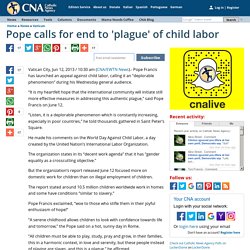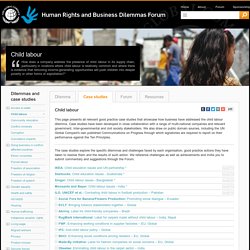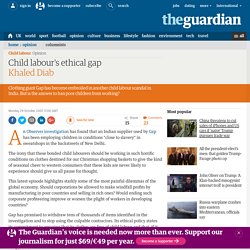

Say No To Child Labour - Child Labour Case Studies. Pope calls for end to 'plague' of child labor. Vatican City, Jun 12, 2013 / 10:30 am (CNA/EWTN News).- Pope Francis has launched an appeal against child labor, calling it an “deplorable phenomenon" during his Wednesday general audience.

“It is my heartfelt hope that the international community will initiate still more effective measures in addressing this authentic plague,” said Pope Francis on June 12. “Listen, it is a deplorable phenomenon which is constantly increasing, especially in poor countries,” he told thousands gathered in Saint Peter’s Square. He made his comments on the World Day Against Child Labor, a day created by the United Nation’s International Labor Organization. The organization states in its “decent work agenda” that it has “gender equality as a crosscutting objective.” But the organization’s report released June 12 focused more on domestic work for children than on illegal employment of children. The report stated around 10.5 million children worldwide work in homes and some have conditions “similar to slavery.” Human Rights and Business Dilemmas Forum - Cases studies. This page presents all relevant good practice case studies that showcase how business have addressed the Child labour dilemma.

Case studies have been developed in close collaboration with a range of multi-national companies and relevant government, inter-governmental and civil society stakeholders. We also draw on public domain sources, including the UN Global Compact's own published Communications on Progress through which signatories are required to report on their performance against the Ten Principles. The case studies explore the specific dilemmas and challenges faced by each organisation, good practice actions they have taken to resolve them and the results of such action. We reference challenges as well as achievements and invite you to submit commentary and suggestions through the Forum.
IN-DEPTH (Print seperately) IKEA: Child education issues and UN partnership * IN-DEPTH (Print seperately) Starbucks: Child education issues - Guatemala * Human Rights and Business Dilemmas Forum - Dilemmas. This page presents an introduction to and analysis of the dilemma.

It does so through the integration of real-world scenarios and case studies, examination of emerging economy contexts and exploration of the specific business risks posed by the dilemma. It also suggests a range of actions that responsible companies can take in order to manage and mitigate those risks. "How does a company address the presence of child labour in its supply chain, particularly in locations where child labour is relatively common and where there is evidence that removing income-generating opportunities will push children into deeper poverty or other forms of exploitation? " Child labour within a company's supply chain The dilemma for responsible business is how to address child labour responsibly given the complex social and economic context in which it occurs.
Real-world examples. Is child labor ethical? Child labour lets us lead sustainable lives.

Someone has to suffer. It's impossible for everyone to live equal life's, someone always misses out. If child labour was disallowed, the clothing industry would probably collapse. These children should have the right to work if they wish, and if their family is unable to provide income themselves. Most countries where child labour occurs are already too poor to provide things like education, health care etc. Child labour's ethical gap. An Observer investigation has found that an Indian supplier used by Gap has been employing children in conditions "close to slavery" in sweatshops in the backstreets of New Delhi.

The irony that these bonded child labourers should be working in such horrific conditions on clothes destined for our Christmas shopping baskets to give the kind of seasonal cheer to western consumers that these kids are never likely to experience should give us all pause for thought. This latest episode highlights starkly some of the most painful dilemmas of the global economy. Should corporations be allowed to make windfall profits by manufacturing in poor countries and selling in rich ones? Would ending such corporate profiteering improve or worsen the plight of workers in developing countries? Gap has promised to withdraw tens of thousands of items identified in the investigation and to stop using the culpable contractors.
According to the UN, a fifth of India's GDP is produced by 55 million children. Supply Chain Management: When Child Labor is Ethical. Multinational corporations have experienced withering criticism for employing children in Asian factories.

On the surface, this practice appears to be unethical. But is it? When we study supply chain management, I engage my students in a discussion of this topic. Here is the scenario: “Major corporations with overseas subcontractors (such as Ikea in Bangladesh, Unilever in India, and Nike in China) have been criticized often with substantial negative publicity, when children as young as 10 have been found working in the subcontractor’s facilities. A student of mine from India said that the decision to hire the child was ethical; and the judgment to fire him was unethical. After all, during the 19th century, the U.S. was once a developing country. It is useful to examine public policy decisions through the lenses of utilitarianism. Several years ago, Nike initiated a compromise solution. Ethical Trading Initiative.